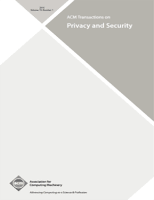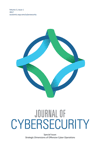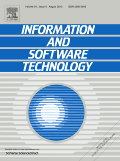
Information and Computer Security
Scope & Guideline
Advancing the Frontiers of Information Security
Introduction
Aims and Scopes
- Human Factors in Cybersecurity:
A significant focus on the psychological and social aspects of cybersecurity, exploring how individual behaviors, perceptions, and motivations influence security practices. - Organizational Security Practices:
Investigating how organizations implement security policies and practices, including the effectiveness of training programs and the impact of organizational culture on compliance. - Technological Innovations:
Examining the role of emerging technologies, such as artificial intelligence and cybersecurity tools, and their implications for enhancing security measures. - Policy and Regulatory Frameworks:
Analysis of laws, regulations, and best practices that govern cybersecurity, including the effectiveness of information security policies in various contexts. - Risk Management and Incident Response:
Focusing on strategies for identifying, managing, and responding to cybersecurity risks, including the dynamics of incident reporting and risk communication. - Education and Awareness:
Promoting cybersecurity education and awareness initiatives, particularly in vulnerable sectors such as healthcare and education, to foster better security behaviors.
Trending and Emerging
- Human-Centric Cybersecurity:
There is a growing emphasis on understanding the human aspects of cybersecurity, including users' behaviors, motivations, and psychological factors, which are critical for enhancing security practices. - Integration of AI and Automation:
Research exploring the applications of artificial intelligence and automation in cybersecurity is on the rise, focusing on how these technologies can improve threat detection, response, and overall security management. - Behavioral Insights into Cybersecurity:
Emerging themes include the application of behavioral theories to understand user interactions with security measures, indicating a shift towards more nuanced approaches to influence secure behaviors. - Supply Chain Security:
Increasing attention is being paid to the security of digital supply chains, particularly in light of recent global incidents that have highlighted vulnerabilities in interconnected systems. - Cybersecurity Education and Training Innovations:
Innovative approaches to cybersecurity education, including gamification and experiential learning methods, are trending as effective means to enhance engagement and retention of security knowledge among users.
Declining or Waning
- Traditional Technical Security Measures:
There seems to be a waning focus on traditional technical measures (e.g., firewalls, antivirus software) as the primary means of securing systems, with more emphasis now placed on human factors and behavioral approaches. - General Awareness Campaigns:
The effectiveness of generic cybersecurity awareness campaigns appears to be decreasing, as research shifts towards more targeted and evidence-based strategies that address specific user behaviors and contexts. - Static Risk Assessment Models:
Static models for risk assessment are being replaced by dynamic, context-aware approaches that account for the evolving nature of threats and vulnerabilities in real-time. - Cybersecurity in Isolated Contexts:
Research focusing on cybersecurity issues in isolated contexts (e.g., specific industries without broader implications) is declining in favor of studies that explore cross-industry and interdisciplinary approaches. - Overemphasis on Compliance:
The focus on compliance-driven approaches to information security is diminishing, as organizations seek more holistic and integrated security strategies that prioritize proactive risk management over mere compliance.
Similar Journals

ACM Transactions on Privacy and Security
Empowering Innovations in Privacy and Security.ACM Transactions on Privacy and Security, published by the Association for Computing Machinery, is a prestigious journal dedicated to the field of computer science, with a particular focus on privacy and security in modern computing environments. Since its inception in 2016, this journal has become a vital resource for researchers, professionals, and students alike, addressing the increasing concerns surrounding data protection and risk management. With an impressive impact factor and recognition as a Q1 journal in both Computer Science (Miscellaneous) and Safety, Risk, Reliability and Quality, it ranks among the top publications in its field, positioned at the 73rd percentile in General Computer Science and the 71st percentile in Engineering. The journal’s Open Access options enhance accessibility to cutting-edge research, fostering collaboration and innovation in the rapidly evolving landscape of privacy and security. Readers can expect high-quality peer-reviewed articles that contribute significantly to both theoretical and practical advancements in technology and data security.

International Journal on Information Technologies and Security
Pioneering Solutions for Digital SafetyInternational Journal on Information Technologies and Security, published by UNION SCIENTISTS BULGARIA, is a pivotal interdisciplinary journal that explores the rapidly evolving fields of information technology and security. With a robust ISSN of 1313-8251, this journal serves as a platform for researchers, professionals, and students to disseminate their findings and innovations in cybersecurity, data protection, and IT system integrity. The journal's commitment to open access enhances accessibility, ensuring that pivotal research reaches a broader audience, encouraging collaboration and advancement in these critical areas. As an invaluable resource for those engaged in the study and application of information security measures, the International Journal on Information Technologies and Security plays an essential role in shaping the discourse and driving forward the knowledge necessary to tackle today’s technological challenges.

Journal of Cybersecurity
Connecting academia and practice in the realm of cybersecurity.Journal of Cybersecurity is a prestigious and impactful academic journal published by Oxford University Press, dedicated to advancing the field of cybersecurity through rigorous research and innovative scholarship. First established in 2015, this Open Access journal has positioned itself as a vital resource for researchers, practitioners, and policymakers alike, contributing significantly to the global dialogue on cybersecurity challenges and solutions. With a commendable reputation reflected in its 2023 category quartile rankings, including Q1 in Safety Research and Q1 in Political Science and International Relations, it serves as a key forum for interdisciplinary studies and discussions surrounding developments in Computer Science, Information Systems, and Social Psychology. The journal not only aims to publish high-quality research but also encourages collaboration across various domains, ensuring that critical insights into cybersecurity resonate across both academic and practical landscapes. By offering Open Access options, the Journal of Cybersecurity empowers a diverse audience to engage with cutting-edge findings and innovations, reinforcing its commitment to an inclusive and globally informed scholarly community.

European Security
Exploring the Complexities of Security and CooperationEuropean Security is a leading interdisciplinary journal published by ROUTLEDGE JOURNALS, TAYLOR & FRANCIS LTD, dedicated to advancing the understanding of security issues within the realms of Political Science and International Relations. With an impressive Impact Factor and a Q1 ranking in its field as of 2023, this journal has solidified its position as an influential platform for scholars and practitioners alike, ranking #93 out of 706 in the Scopus database. Since its inception in 1992, European Security has provided a forum for original research, analytical essays, and review articles that explore the complexities of security, conflict, and cooperation in the European context and beyond. The journal's commitment to high-quality scholarship is reflected in its rigorous peer-review process and the diverse perspectives it fosters. Although offering subscription-based access, the content within is invaluable for anyone engaged in the study of contemporary security challenges. Whether you are a researcher, professional, or student, European Security is essential reading for deepening your understanding of the dynamic and evolving landscape of international security.

Cryptography, an esteemed journal published by MDPI, focuses on the rapidly evolving fields of cryptography and information security, providing a platform for researchers and practitioners to share their findings and advancements. Since its inception in 2017, it has embraced an Open Access model, allowing unrestricted access to high-quality research articles, thereby fostering collaboration and innovation among academics globally. Based in Switzerland, this journal aims to cover a broad spectrum, from theoretical foundations to practical applications, contributing significantly to fields such as Applied Mathematics and Computer Science. Its impressive rankings in reputable databases like Scopus reflect its relevance and quality, holding a Q2 category in multiple disciplines, including Computational Theory and Mathematics and Computer Networks and Communications. With the continuous rise in importance of cybersecurity and data protection, Cryptography serves as a vital resource for professionals, students, and researchers dedicated to advancing knowledge in these critical areas.

Journal of Military and Strategic Studies
Exploring Innovative Perspectives on Defense and Strategy.Journal of Military and Strategic Studies, published by UNIV CALGARY PRESS, is a leading peer-reviewed open-access journal dedicated to advancing the field of military and strategic studies. Since its inception in 1998, this journal has provided a platform for the dissemination of innovative research and critical thought on military history, strategic theory, and contemporary defense issues, making it an essential resource for scholars, practitioners, and students alike. With an unwavering commitment to intellectual rigor, the Journal of Military and Strategic Studies serves not only as a repository of knowledge but also as a vibrant forum for discussion and debate, contributing to the evolving discourse in security studies and international relations. Researchers and professionals will find valuable insights and diverse perspectives that explore the complexities of military strategy and its implications on global stability. Access to the journal is fully open, allowing unrestricted sharing of knowledge and fostering collaboration within the academic community.

INFORMATION AND SOFTWARE TECHNOLOGY
Catalyzing Knowledge in Software Development and Information SystemsINFORMATION AND SOFTWARE TECHNOLOGY, published by Elsevier, is a leading journal that stands at the forefront of the fields of software engineering, information systems, and computer science applications. Since its inception in 1970 and with a focus extending to 2025, this esteemed publication has made significant contributions to the discourse on technological advancements and innovations. In 2023, it has achieved a remarkable Q1 categorization across multiple domains, including Computer Science Applications, Information Systems, and Software, reflecting its excellence and relevance in the academic community. With Scopus rankings that place it in the top percentiles in its categories (85th, 83rd, and 83rd respectively), the journal serves as an essential platform for researchers, professionals, and students eager to disseminate and engage with cutting-edge research and developments. While it does not currently offer Open Access options, the knowledge curated within its pages remains invaluable for advancing the fields of information technology and software development.

KSII Transactions on Internet and Information Systems
Pioneering Research for a Digital Tomorrow.KSII Transactions on Internet and Information Systems is a leading academic journal dedicated to advancing the fields of Internet technology and information systems. Published by the KSII-Kor Soc Internet Information, this journal has established itself as a significant contributor to research since its inception in 2007, with a focus on innovative solutions and methodologies in computer networks and communications as well as information systems. With a Category Quartile of Q3 in both fields for 2023, it ranks in the 44th percentile among its peers according to Scopus, making it a reputable platform for authors to share their findings. While available in print, the journal also promotes open access, ensuring broad dissemination of research findings. The editorial team is committed to maintaining high scholarly standards and relevance, inviting contributions from researchers, professionals, and students eager to push the boundaries of knowledge in today's rapidly evolving digital landscape. For those engaged in or studying these dynamic fields, the KSII Transactions on Internet and Information Systems remains an invaluable resource for cutting-edge research.

KOREAN JOURNAL OF DEFENSE ANALYSIS
Advancing the discourse on defense and security.Korean Journal of Defense Analysis (KJDA) is a pivotal academic publication committed to advancing research in the realms of Political Science, International Relations, and Safety Research. Established by the Korea Institute for Defense Analyses (KIDA) in South Korea, this journal serves as a vital platform for scholars, practitioners, and policymakers interested in defense strategies and security studies. With an ISSN of 1016-3271 and an E-ISSN of 1941-4641, KJDA offers rigorous peer-reviewed articles that contribute to the theoretical and empirical understanding of defense and safety issues. As of 2023, it holds a reputable standing within various categories, ranked in the Q3 and Q4 quartiles, reflecting its significance and influence in the field. Although not an Open Access journal, KJDA provides essential insights spanning from 1996 through to 2024, attracting a diverse readership ranging from researchers to students eager to explore contemporary defense analysis and its implications on global security dynamics. With a dedicated commitment to quality and relevance, KJDA remains an indispensable resource in the ongoing discourse surrounding defense and safety.

Journal of Information Assurance and Security
Innovating Solutions for a Safer Digital Realm.Journal of Information Assurance and Security, an esteemed publication by DYNAMIC PUBLISHERS, INC, serves as a pivotal platform for the dissemination of innovative research and insights in the field of information security and assurance. With its ISSN 1554-1010 and E-ISSN 1554-1029, this journal addresses critical vulnerabilities, emerging technologies, and methodologies that fortify data integrity and uphold privacy in our increasingly digital world. Although specific metrics such as the HIndex and Scopus ranks are currently unavailable, the journal is recognized for its contributions to both academia and industry, fostering collaboration among researchers, professionals, and students dedicated to advancing security protocols. The journal does not currently offer open access but ensures comprehensive accessibility through institutional subscriptions. As cybersecurity continues to be a paramount concern globally, the Journal of Information Assurance and Security stands out as an essential resource for groundbreaking studies and practical applications that drive the future of information protection.